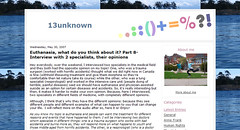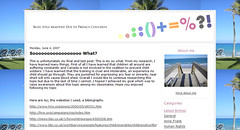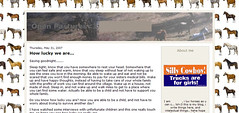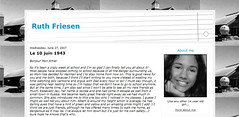Creating Learning Experiences
I've spent the last couple of days thinking about the tools I will use next term with my classes (21classes? Edublogs? Ning? Wikispaces? PBWiki? MindMeister?) only to discover that what I'm really interested in is preparing the ground for learning. I don't want to structure and pre-define. I do not want to create a community or a social network for my students. Instead, I want to create the conditions necessary for the right kind of environment to emerge. Building an environment for the students is likely to result in failure: environments and communities need to be build with the students, with their full participation, through their work and their interactions with and about texts. It's not just about choosing a blogging platform and letting the kinds in. We need to move beyond the traditional approach of "pick the tools, add students and stir." Unfortunately, my curriculum is still to a large extent dominated by units, lessons, assignments. Those are the realities of teaching and learning in North America in the 21st century - it's not about the process, it's about the product. So, as a teacher in the 21st century, I am taking a stand: I want to have a classroom where my students can enjoy learning experiences. Instead of dividing the curriculum into neat chunks, I will try to set the stage for the right kind of environment to emerge - the kind of environment where learning experiences can take shape. The kind of environment that is similar to what Ben Wilkoff has termed, "the ripe environment," one characterized by "a culture of connection."
Before I explain what I have in mind, let me take you back to last term. I'd like to tell you about Vanessa. Last term, she chose to research child soldiers. She spent months reading articles, interviews, watching online videos, and documenting her research on her blog. Gradually, she immersed herself in her topic and learned much more than I ever could have taught her. Then, towards the end of the term, after documenting her research, reflecting on it, and sharing it with her classmates, she started writing poetry in response to this gruesome and difficult topic. Take a look:
I am part of the Revolutionary United Forces and I will stop at nothing for victory... To overthrow the enemy one must not abide by the rules, Governing ourselves, altering the thoughts of many Vulnerability in a child is our advantage Even in the children's eyes, death is to be taught as the answer The children have sorrow in their eyes longing for love They cry, Scream, Weep for love,
Defeating the enemy, is of the utmost importance No sympathy, no traitors, no survivors The child's innocence will not affect us, Risking their lives will lead us closer to victory. The children have sorrow in their eyes longing for hope, They cry, Scream, Weep for hope
Respect given to the children will conquer any love once given to them Our training methods constant and cruel On the front lines of battle, they shed blood for us We are the R.U.F's, envisioning only supremacy The children have sorrow in their eyes longing to defeat the enemy They cry, Scream, Weep for victory.
I realized that this was a genuine personal response, indicative of a lot of personal investment in the topic. It was a kind of personal way of coming to terms with what she had learned. Vanessa wasn't the only one. Trudy, who'd spent months researching Anne Frank, also posted some poetry:
The book opens A new piece of information is just being handed to you But you know at the end something dark awaits And lets just say its not a happy ending
You read the beginning and then the end Throughout each day personalities change Feelings change It is a new type of life unfolding right in front of your eyes
You witness life in the eyes of a young girl The way she writes the way she explains, Its like its happening To you Right this very moment Everyday sounds and voices scare you But shes just a 13 year old girl what can she do? Nothing
New laws, new relationships are all so different Its kind of like beginning a new life Like a caterpillar growing into a butterfly A new life unfolds
No fun, no friends Just your family With petite spaces and little boundaries Closed windows make you want to witness nature But you can't
A new love, Someone to share your feelings with But is it true? Or have you just gotten to the point you can't think and you do things that you would never do in you old life
So many rules to follow: Be Quiet! Walk Slowly! Sit Down during the day! Read, write just be quiet....during the day!
When the sun has gone down and the moon has gone up There are different rules: Walk Around Be Free But Don't open the windows Or go outside!
With every pleasant thing you do, There will always be a consequence During this time of your life
All the personalities change so quickly Funny Talkative Sometimes even ignorant Personal
There is so much time but soon.... Sooner than you think There will be no more time left.
At first, while certainly very impressed by the creative work of these thirteen-year-olds, I did not think that there was anything out of the ordinary about it. Then, I realized that there was. Having become researchers (one might even say content experts) in their respective fields, Vanessa and Trudy started contributing. Yes, contributing! We don't often think of students as contributors. Even in the context of Web 2.0, I often talk about collaboration and connections, but rarely about genuine contributions. These poems, it occurred to me one day, are learning objects - they are unique artifacts that I can use next year with another class when discussing child soldiers or Anne Frank. Much like edubloggers around the world who, through my aggregator, contribute to my knowledge of learning in the 21st century, these girls were contributing specific artifacts to the topics they chose to study.
I started thinking about their progress as researchers and it occurred to me that the whole class seemed to follow the same pattern. Once I gave them the freedom to find a topic they were interested in, they began to seek out and immerse themselves in learning experiences. No one really seemed to care about grades or tests. Instead, they were immersed in learning about topics they cared about. Looking back, I realize that the process that the whole class engaged in consisted of four stages. Vanessa and Trudy, however, moved beyond into the fifth stage. The girls, along with their classmates, inspired me to start thinking about the process of creating learning experiences. The five stages described below illustrate my emerging approach based on my classroom practice and the work of my students (be kind - it's still a work in progress):
1. DISCOVER: First, the students were given the freedom to pick a topic of interest within a specific context that we had entered through our discussions of literature - the context of social justice. I gave all my students sufficient time to think about what they were passionate about, visit some sites, read some articles and uncover that one specific topic that they wanted to learn more about.
At this point, the students were really just surfing and lurking. They were visiting various sites and communities to explore topics that were of interest to them as potential ideas for future research. There were no conversations here, just fleeting interactions.
2. DEFINE: During this stage, I gave the students time to post some preliminary entries on their blogs, to think out loud about their topics in general terms before they started their research. The point here was to allow them the freedom to start defining their research topics and possible ways of tackling them.
3. IMMERSE: The next step was the longest and most complex. Having narrowed it down to a specific topic, the students then were given time in class to immerse themselves in the topic, to learn more about it, to start looking for, identifying, and interacting with valuable resources. This was an opportunity to bookmark relevant content and use RSS to start creating a network of valuable and reliable resources (I want to extend it this year to a network of peers and adult experts). I wanted my students to become researchers who locate valuable content, read, interact, and document their learning on the blog by writing entries about the topic and their journey as researchers.
4. BUILD: The students' efforts to document their discoveries and their learning contributed to the process of building their own knowledge in this specific area. The entries showed me and their peers - our whole community - how much they were learning. These were thoughts made visible. The students used their blogs to document their research and to build their own knowledge in their respective fields of expertise. There were many connections that emerged among students researching related ideas. The students interacted with each other by posting comments and by sharing and commenting on resources. They were engaged in their own research projects as individual researchers but, at the same time, there emerged many small networks within our class blogosphere of students interested in similar topics. They were all engaged and connected.
And that was where the process ended, or so I thought until I noticed Vanessa's poem and then Trudy's. Both girls were contributing unique, personal content to the fields they chose to research. That's when I realized that in order for the learning experience to be complete, the students needed to go beyond researching, connecting, and network-building to become creators and contributors. Of course, one could argue that their research entries contributed valuable material to our class community, but this - their poetry - was unique and personal. These were artifacts which, despite their personal, literary, and creative nature, could enrich anyone's understanding of child soldiers or Anne Frank. They emerged because the girls went beyond the process of documenting their research.
So, I realized that there was one more, final stage in this process.
5. CONTRIBUTE: This final stage happens when, as learners, the students begin to contribute through their own creativity. It happens when, having acquainted themselves with the topic, they begin to rewrite or remix it in their own unique way and thus contribute to and enrich the field they're researching. This is the stage when the students begin to create unique artifacts that contribute to the existing body of knowledge on a given topic. This final stage is not just about contributing links or resources to a group project or to a community. It is primarily an exercise in creativity. It begins when the students interact with ideas, resources, and people to create or enter a network. Once they can tap into the collective intelligence of their networks, they can begin to learn, and once they begin to learn, they can also begin to create their own resources - podcasts, films, creative writing, or any other artifacts that can then be used by others and can enrich their grasp of the topic.
Why can't this fifth stage replace my traditional evaluation strategies? Why can't I replace tests or assignments given to the whole class with the kind of engaging and personally relevant approach to learning that is encapsulated in the five-stage process above?
I think it can certainly be accomplished but, first, I need to foster in my classroom the kind of environment where this five-stage process can take place. This means that I need to think about how to create the kind of environment that fosters and supports learning experiences, not the kind of environment that imposes them on students. Perhaps, what I'm really interested in is what Dave Cormier calls "habitat." He states that a proper habitat can "make it more likely for community to form and more likely that that community will do the kinds of things that were intended … that prompted the creation of that habitat." In other words, as Dave argues, "a careful attention to the construction of habitat can increase the chances of a community forming." I spent the last three years creating communities with my students and I learned that if the right (ripe?) environment is there, the community will emerge. It seems to me that the approach I described above can help create the kind of habitat that will lead to the emergence of networks, correspondences, and - most importantly - contributions.
In order to make all of this happen in a grade seven or eight Language Arts classroom, I need to think about facilitating connections and supporting my students in the process of creating their own networks where their contributions - poems, interviews, chatcasts, blog entries, podcasts, films - will be seen as enriching artifacts.








